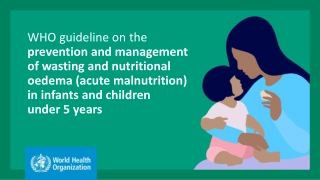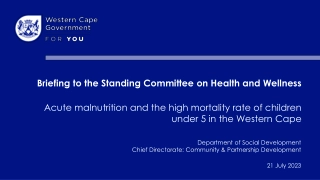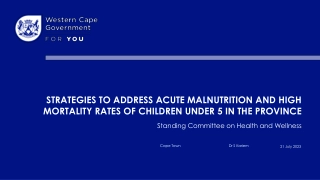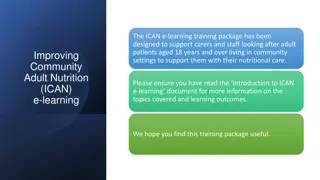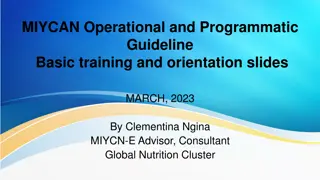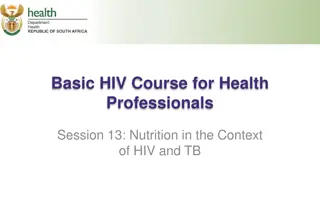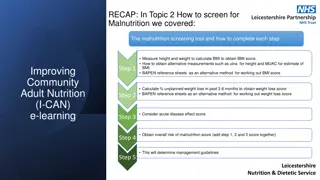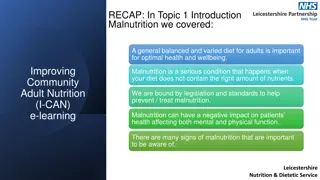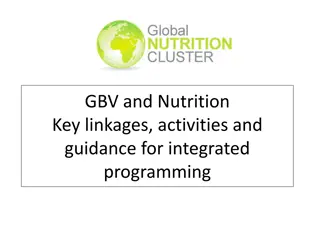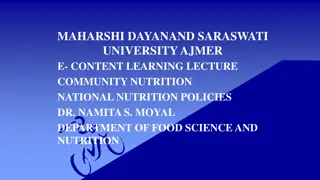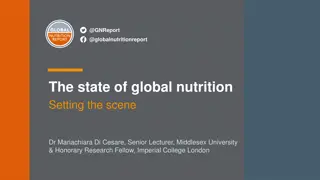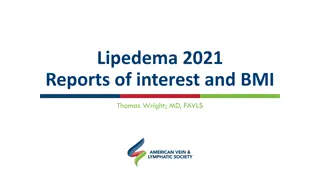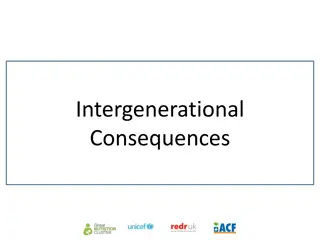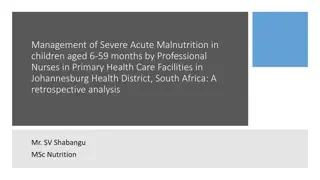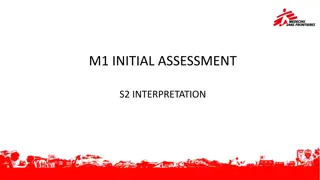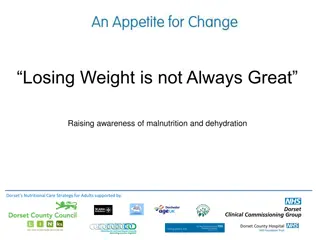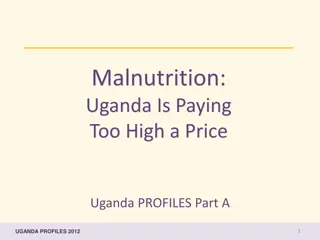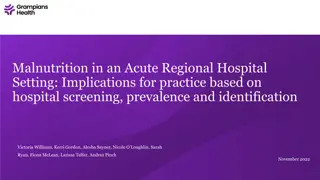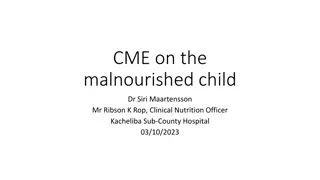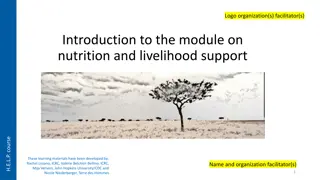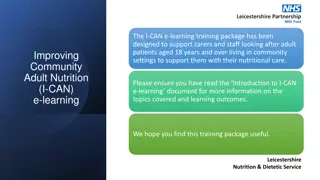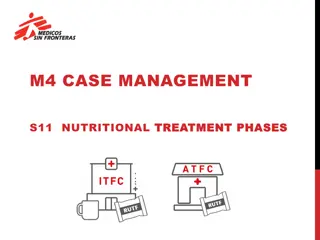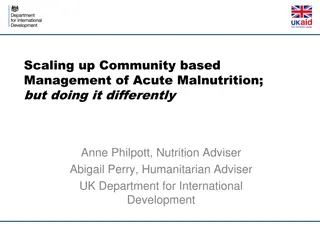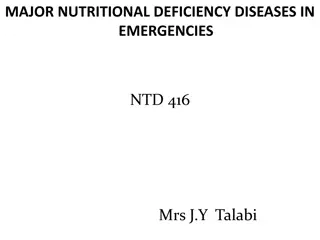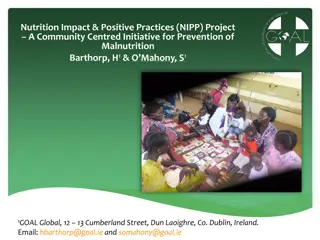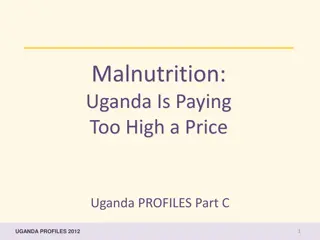WHO Guideline: Prevention & Management of Malnutrition in Infants & Children
Key insights from WHO's guideline on managing wasting and malnutrition in children under 5. Covers assessment, care for infants and mothers, and treatment strategies for different malnutrition levels
3 views • 37 slides
Addressing Acute Malnutrition and High Child Mortality in Western Cape: Community Development Strategies
Update on the strategies implemented by the Chief Directorate to combat acute malnutrition and high mortality rates among children under 5 in the Western Cape. The Sustainable Livelihoods Programme focuses on social inclusion and poverty alleviation through targeted feeding and access to government
8 views • 14 slides
Strategies for Managing Malnutrition with Nutritional Care Plans
Understanding how to create and implement a nutritional care plan based on the MUST score, including strategies like Food First and Fortification, can help manage malnutrition effectively. This involves utilizing nutrient-dense foods, promoting wound healing, increasing muscle strength, and improvin
0 views • 18 slides
Treatment of Acute malnutrition using Simplified Approaches.
Simplified approaches in the treatment of acute malnutrition involve modifications to existing protocols to optimize effectiveness, quality, and cost-efficiency. These approaches include family MUAC screening, CHW-led treatment, reduced follow-up visits, expanded admission criteria, single treatment
1 views • 15 slides
Nutritional Care Planning for Malnutrition Screening
Learn how to screen for malnutrition using tools like BMI calculation and weight loss assessment. Understand the steps to create a nutritional care plan based on MUST scores, including setting aims, implementing agreed plans, and monitoring progress. Gain insights into managing malnutrition risks an
1 views • 12 slides
Strategies to Address Acute Malnutrition and High Mortality Rates in Children Under 5
Malnutrition in children under 5, specifically acute malnutrition, is a pressing issue in the Western Cape. This presentation outlines the current strategies, multisector engagement, causes, and impacts of acute malnutrition. It delves into the classifications of malnutrition, including severe and m
1 views • 38 slides
Screening for Malnutrition with MUST Tool
Understanding malnutrition is crucial for maintaining optimal health. Screening with the Malnutrition Universal Screening Tool (MUST) is essential to identify individuals at risk. This tool involves assessing BMI, calculating weight loss scores, and determining overall malnutrition risk. Proper scre
5 views • 25 slides
Supporting Adult Nutrition in Community Settings - ICAN E-Learning Training
The ICAN E-Learning Training Package is designed to assist carers and staff caring for adult patients aged 18 and over in community settings with their nutritional care. The training covers topics such as national standards in nutrition, defining malnutrition, causes and consequences of malnutrition
7 views • 10 slides
Nutrition Emergency Response in Palestine: Addressing Wasting and Malnutrition
The nutrition situation in Gaza, Palestine is dire, with a significant proportion of the population experiencing food insecurity and malnutrition. A flash appeal highlights the urgent need for funding to support nutrition interventions, especially for vulnerable groups such as infants and pregnant w
4 views • 14 slides
Improving Maternal and Child Nutrition in Somalia: Challenges and Solutions
Addressing the nutritional challenges faced by women and children in Somalia, including high rates of anemia, inadequate breastfeeding practices, and malnutrition. Factors contributing to malnutrition such as poor diets, limited access to essential services, and gender inequalities are highlighted.
0 views • 12 slides
Importance of Nutrition in the Context of HIV and TB
Malnutrition is common in people living with HIV and TB, exacerbating immune suppression and disease progression. Good nutrition can strengthen the immune system, improve drug adherence, and manage symptoms, while poor nutrition weakens immunity and increases vulnerability to infections. Consequence
2 views • 20 slides
Efficient Estimation and Planning for Malnutrition Caseloads
Recognize and establish methodologies for calculating supply caseloads, consolidate practices for estimating caseloads in malnutrition treatment, and make informed decisions on data selection to identify target caseload in the case study country. Find relevant info, estimate caseloads for SAM and MA
0 views • 13 slides
Global Nutrition Prevalence Rates in Children and Women
This content highlights the prevalence rates of acute malnutrition, severe acute malnutrition (SAM), moderate acute malnutrition (MAM), childhood stunting, acute malnutrition based on MUAC and edema, and acute malnutrition in pregnant and lactating women. The data is based on various criteria such a
9 views • 37 slides
Understanding Malnutrition Screening and Nutritional Care Planning
In this overview, discover the process of screening for malnutrition, including calculating BMI, assessing weight loss, and determining overall malnutrition risk. Explore how to create a nutritional care plan based on the MUST score and set appropriate nutritional aims for patients.
0 views • 12 slides
Understanding Malnutrition Screening with MUST Tool
Delve into the importance of malnutrition screening with the Malnutrition Universal Screening Tool (MUST). Learn how to calculate BMI, assess weight loss, and determine overall malnutrition risk. Discover the key steps involved in using the MUST tool for effective patient care and management.
1 views • 25 slides
Integrating GBV and Nutrition: Key Linkages and Strategies
Gender-based violence (GBV) and nutrition are interconnected, with GBV being a key driver of malnutrition. Integrating GBV into nutrition programs can improve response quality, mitigate malnutrition risks, and reach vulnerable populations effectively. This integration enhances the safety, accessibil
1 views • 17 slides
Alarming Malnutrition Situation in India: National Nutrition Policy and Strategies
Malnutrition remains a serious issue in India, with high rates of underweight, stunting, and wasting among children. The National Nutrition Policy emphasizes the need for a comprehensive approach to address the complexities of malnutrition. Despite some improvements, malnutrition continues to impact
0 views • 44 slides
Global Nutrition Report 2019: Progress Against Malnutrition Targets
The Global Nutrition Report tracks progress and actions against global nutrition targets, aiming for a world free from malnutrition. Despite efforts, no country is on track to meet targets for adult obesity and anemia in women. The report highlights the coexistence of wasting, stunting, and overweig
0 views • 18 slides
Insights on Lipedema: Surgery, Outcomes, and Malnutrition
Lipedema reduction surgery in the US has shown positive outcomes in quality of life, pain relief, and weight loss, though complications can arise. Understanding the benefits and risks is essential for patients considering this procedure. Additionally, misdiagnosing lipedema as obesity can lead to is
0 views • 19 slides
Understanding Protein Energy Malnutrition (PEM): Signs, Symptoms, and Treatment
Protein Energy Malnutrition (PEM) is a serious nutritional disorder resulting from a deficiency of macronutrients, energy, and protein in the diet. This article explores the different types of PEM, focusing on clinical forms like Kwashiorkor, Marasmus, and Marasmic Kwashiorkor. Detailed descriptions
0 views • 20 slides
Role of Anganwadi Workers in Combating Child Malnutrition in India
Anganwadi workers play a crucial role in addressing child malnutrition, infant mortality, and lack of education in India. They operate under the Integrated Child Development Services (ICDS) scheme, providing essential healthcare, nutrition, and educational support to children aged 0-6 years. With a
0 views • 10 slides
UNICEF Conceptual Framework on the Causes of Malnutrition
The UNICEF conceptual framework on the causes of malnutrition outlines the multidimensional factors contributing to malnutrition, categorized into immediate, underlying, and basic causes. Immediate causes include inadequate dietary intake and diseases, while underlying causes involve issues like ina
2 views • 18 slides
Enhancing Nutritional Security in SADC Communities through Sugar Fortification
Nutritional security is crucial for overall well-being, and this presentation explores the significant role of sugar fortification in improving micronutrient intake and combating malnutrition in SADC regions. Insights into the current status quo, strategies for enhancing micronutrient intake, and th
0 views • 15 slides
Understanding Intergenerational Consequences of Malnutrition
Exploring the short-term and long-term impacts of malnutrition on mortality, morbidity, disability, cognitive development, health, and economic productivity. Investigating the underlying and immediate causes such as inadequate dietary intake, disease, household food insecurity, and inadequate food,
2 views • 16 slides
Inpatient Management of Severe Acute Malnutrition Training Course 2011
This training course focuses on inpatient management of severe acute malnutrition, teaching procedures outlined in the national Community-Based Management of Severe Acute Malnutrition Guidelines. The training aims to reduce case fatality rates significantly and is designed for physicians, senior nur
0 views • 9 slides
Acute Malnutrition - Fluid Management and Treatment Overview
Acute malnutrition, particularly severe acute malnutrition (SAM), requires careful fluid management and a structured treatment approach involving stabilization, transition, and rehabilitation phases. This condition results from inadequate dietary intake or acute infections, leading to severe wasting
0 views • 23 slides
Management of Severe Acute Malnutrition in Children: A Retrospective Study in Johannesburg Health District
Severe Acute Malnutrition (SAM) in children aged 6-59 months is a critical public health concern in Johannesburg, South Africa. This study retrospectively analyzes the classification and management of SAM cases by professional nurses in primary health care facilities. The research highlights the imp
0 views • 14 slides
Understanding Malnutrition Assessment and Classification
Learn how to interpret malnutrition indices, classify types of malnutrition, recognize acute malnutrition, and grade oedema in this informative session. Explore key learning objectives, types of malnutrition, classification of acute malnutrition, and more. Enhance your knowledge to effectively asses
2 views • 10 slides
Understanding the Impact of Malnutrition and Dehydration on Adults
Raising awareness on the risks of malnutrition and dehydration in adults, Dorset's Nutritional Care Strategy highlights the prevalence, causes, and consequences of unintentional weight loss. By shedding light on the alarming statistics and factors contributing to malnourishment, this initiative aims
0 views • 11 slides
Maternal Nutrition Training: Integrating Assessment, Counselling, and Support
Maternal nutrition training session aims to educate health providers on the importance of maternal nutrition, causes and consequences of malnutrition, and strategies to break the malnutrition cycle. The training covers topics like defining maternal nutrition, understanding its significance throughou
0 views • 11 slides
Addressing Malnutrition in Uganda: Challenges and Strategies
Malnutrition remains a critical issue in Uganda, with high rates of stunting, underweight, and micronutrient deficiencies among children and women. The National Development Plan aims to reduce poverty and improve health outcomes through strategies like increasing agricultural productivity and enhanc
0 views • 8 slides
Malnutrition in Acute Hospital Setting: Implications for Practice and Identification
A study on malnutrition in an acute regional hospital setting highlighted a prevalence of 40%, with implications such as impaired wound healing and increased length of stay. Screening tools like the Malnutrition Screening Tool (MST) and Subjective Global Assessment (SGA) were used to assess patients
0 views • 12 slides
Understanding and Managing Malnutrition in Children
Learn about malnourishment in children, including common types like Kwashiorkor and Marasmus, as well as the physiologic consequences and clinical assessments related to malnutrition. Discover key indicators such as weight-for-height, MUAC, and edema, along with micronutrient deficiencies and how th
0 views • 21 slides
Nutrition and Livelihood Support Module: Building Resilience in Crisis Settings
Explore the impact of crises on livelihoods and nutrition, understand malnutrition frameworks, participate in assessments, and identify crisis-appropriate interventions. Delve into basics of nutrition, malnutrition causes, measuring malnutrition, and nutrition programming in crisis contexts. The cou
0 views • 5 slides
Understanding Malnutrition in Adult Patients: I-CAN e-Learning Training Package
The I-CAN e-learning training package is designed to support carers and staff in community settings looking after adult patients aged 18 and over with their nutritional care. It covers topics such as national standards in nutrition, defining a balanced diet, causes and consequences of malnutrition,
0 views • 10 slides
Understanding Nutritional Treatment Phases in Pediatric Malnutrition
This session covers the different phases of nutritional treatment in pediatric malnutrition programs, focusing on objectives, specifics, and criteria for transitioning between phases. An illustrative case of Annika, a 3-year-old in the Transition Phase, is provided for practical application and unde
0 views • 5 slides
Innovative Approaches in Scaling Up Community-Based Management of Acute Malnutrition
Scaling up community-based management of acute malnutrition is vital for reaching vulnerable populations. DFID's efforts in countries like Malawi, India, and Ethiopia showcase unique strategies such as local production of RUTF, piloting CMAM in communities, and integrating CMAM into national nutriti
0 views • 7 slides
Understanding Major Nutritional Deficiency Diseases in Emergencies
Access to food and adequate nutrition is crucial during emergencies to prevent malnutrition-related mortality. Malnutrition results from consuming meals lacking essential nutrients, leading to health issues. Malnutrition in emergencies encompasses acute malnutrition, micronutrient deficiencies, and
0 views • 22 slides
Nutrition Impact & Positive Practices (NIPP) Project Overview
The Nutrition Impact & Positive Practices (NIPP) Project is a community-centered initiative aimed at preventing malnutrition, particularly focusing on women, infants, and young children. GOAL Global designed this project to reduce rates of acute and chronic malnutrition through behavior change inter
0 views • 14 slides
Addressing Malnutrition in Uganda: A Call to Action
Uganda is grappling with the high cost of malnutrition, leading to adverse impacts on health, productivity, and economic development. This collection of presentations emphasizes the urgent need for intervention to prevent further suffering and loss of life. The content highlights the benefits of add
0 views • 7 slides
